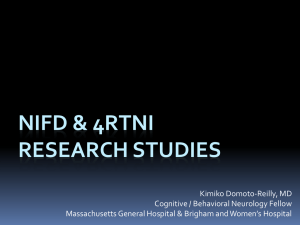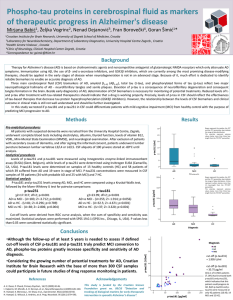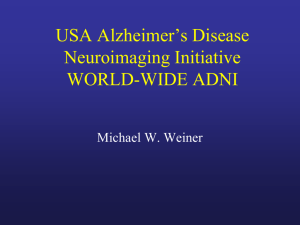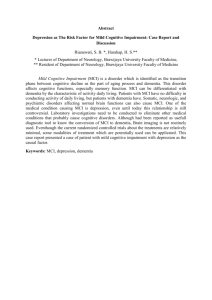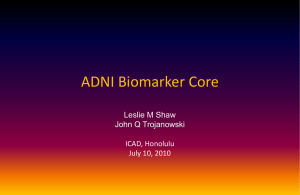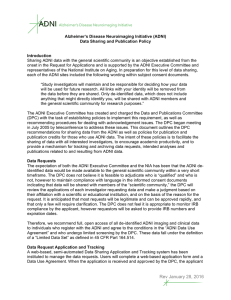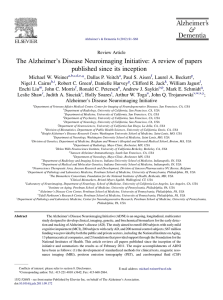Benefits of data sharing and reuse in biomedical research
advertisement
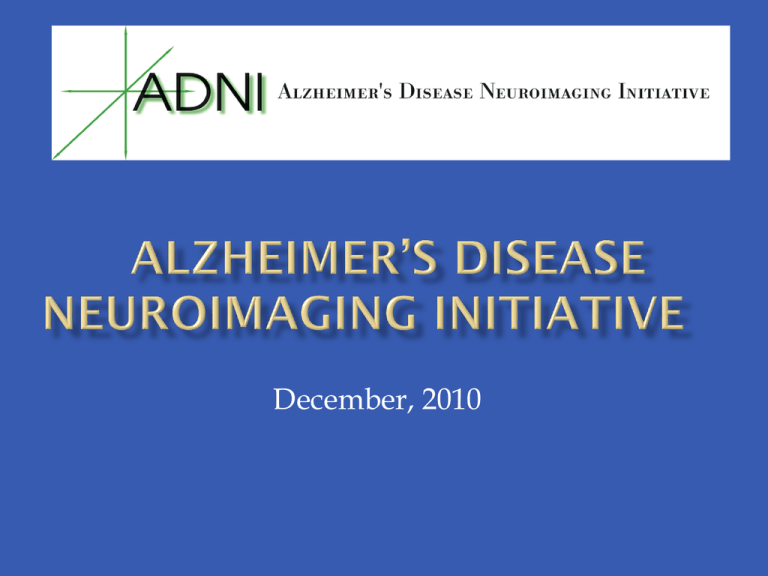
December, 2010 NEED FOR VALIDATED BIOMARKERS FOR AD TRIALS • Biomarkers useful in Phase 2 to make decisions about Phase 3 (e.g. doses) • Biomarkers useful in Phase 3 – Provide additional evidence to support primary outcome findings – Provide evidence for “disease modification” and not simply symptomatic improvement GOALS OF THE ADNI: LONGITUDINAL MULTI-SITE OBSERVATIONAL STUDY • Major goal is collection of data and samples to establish a brain imaging, biomarker, and clinical database in order to identify the best markers for following disease progression and monitoring treatment response • Determine the optimum methods for acquiring, processing, and distributing images and biomarkers in conjunction with clinical and neuropsychological data in a multi-site context • “Validate” imaging and biomarker data by correlating with neuropsychological and clinical data. • Rapid public access of all data and access to samples Normal MCI AD ADNI 2 ADNI 1 (EMCI) (LMCI) 0 0.5 CDR 1 3004153-1 STUDY DESIGN-ADNI1 • • • • • • • • • MCI (n= 400): 0, 6, 12, 18, 24, 36 months AD (n= 200): 0, 6, 12, 24 months Controls (n= 200): 0, 6, 12, 24, 36 months Clinical/neuropsychological evaluations, MRI (1.5 T) at all time points FDG PET at all time points in 50% 3 T MRI at all time points in 25% PIB sub-study on 120 subjects Blood and urine at all time points from all subjects; CSF from 50% of subjects 0, 1 yr, 2 yr (subset); DNA and immortalized cell lines from all subjects GWAS study Subject Evaluation • Baseline/screening eval and q 6 mo. – – – – – – – – – Labs, Apo E Hamilton(S) Beck MMSE ANART ADAS-cog NPI CDR ADL • Neuropsyc(B and q 6 mo) – – – – – – – Logical Memory(S) AVLT BNT Trails A &B Symbol digit Clock drawing Category fluency ADNI Public-Private Partnership Structure Private/Philanthropic + Public David Lee Alison Drone FDA Neil Buckholtz NIBIB, NINDS, NIMH, NIDA, NCRR, NINR ADNI Executive Steering Committee PET Core: Berkeley: Jagust MRI Core: Mayo: Jack Clinical Core: UCSD: Aisen Mayo: Peterson Publications Core: PI: Mike Weiner Administrative Core: UCSF BostonU: Green Biomarkers Core: UPenn: Trojanowski/Shaw Biostatistics Core: UCD: Beckett Informatics Core: Neuropathology Core: UCLA: Toga WashU: Morris 57 Clinical Sites: ADNI PIs and Cores Data and Sample Sharing • Goal is rapid public access of all raw and processed data • Central repository for all QA’d MRI and PET [Laboratory of Neuroimaging, UCLA (LONI)] • Clinical data base at UCSD is linked to LONI • Databases- in the public domain, available to all qualified investigators • Sample sharing-Resource Allocation Review Committee • No special access • Data Sharing & Publication Committee (DPC) -ADNI Data Use Agreement ADNI Demographics Normal controls (n=229) MCI (n=398) AD (n=192) P 76.4 (5.0) 75.3 (7.5) 75.8 (7.4) 0.15 48.0 35.4 47.4 0.002 Years of education, mean (SD) 15.6 (3.1) 16.0 (2.9) 14.7 (3.1) <0.001 Apolipoprotein E e4: Positive (%) 26.6 53.5 65.6 <0.001 Age, mean (SD) Female (%) CP1307278-1 ADAS Cog 11 Feb-09; N. Schuff ADNI Conversion Rates Year Normal MCI MCI AD 0-1 1.4% (0.0-3.2) 16.0% (11.3-20.4) 1-2 2.4% (0.0-4.7) 23.9% (19.0-29.5) 2-3 0.0% (0.0-3.4) 9.1% (5.8-13.5) Diagnosed as AD Diagnosed as NC +2% -2% Lateral View Medial View Holland et al. Statistical ROI’s of 12-Month CMRglDecline AD MCI Mean Cortical SUVR 3 2.5 2 1.5 Cutoff > 1.46 PIB+ (Berkeley Data) 1 Normals MCI AD 9/19 (47%) 47/63 (68%)17/19 (89%) PIB+ PIB+ PIB+ Follow-Up of PIB-Positive ADNI MCI’s ADNI PiB MCI’s N = 65, 12 mo. follow-up PiB(-) Converters to AD PiB(+) 18 3 47 Converters to AD 21 ADNI BASELINE CSF biomarker concentrations show the expected average differences between AD and MCI and NC AD (n=102) Mean±SD Tau Ab1-42 P-Tau181P Tau/Ab1-42 P-Tau181P/Ab1-42 122±58 143±41 42±20 0.9±0.5 0.3±0.2 103±61 164±55 35±18 0.8±0.6 0.3±0.2 70±30 206±55 25±15 0.4±0.3 0.1±0.1 MCI (n=200) Mean±SD NC (n=114) Mean±SD p<0.0001, for each of the 5 biomarker tests for AD vs NC and for MCI vs NC. For AD vs MCI:p<0.005, Tau; p<0.01, Ab1-42; p<0.01, P-Tau 181P; p<0.0005, Tau/Ab1-42; p<0.005, PTau 181P/Ab1-42. Mann-Whitney test for statistical differences used for these non-normally distributed data sets. MCI progressors to AD at YEAR 1(n=37) MCI converters to normal Ab1-42 concentrations in CSF, collected at the baseline visit, of 37 ADNI MCI subjects who at their one year visit converted to a diagnosis of probable AD. The data points for the MCI→AD converters are presented as a horizontal dot plot with the x axis scale identical to that of the Ab1-42 frequency plot for the entire ADNI MCI group. The vertical line indicates the Ab1-42 cutoff concentration obtained from ROC analysis of an ADNI-independent cohort of autopsy-based AD subjects’ CSF. Recommendation for revised Project Plan study design • RBM has agreed to run 1,000 samples using the full panel (500 at baseline, 500 at one year): • • • • • 300 MCI samples each 100 AD samples each 100 control samples each Include all subjects with CSF and PIB PET data. Try to balance non-progressor MCI vs progressing MCI. Hippocampal atrophy rates (L+R) – free surfer data – in ADNI subjects with CSF Ab1-42 >192 pg/mL or <192 pg/mL Hippocampal % atrophy rates (BL→12 mos), for ADNI subjects with Ab1-42< 192 or >192 pg/mL Ab1-42 <192pg/mL Ab1-42 >192pg/mL ALL AD MCI -5.6±4.7 -2.6±4.1 -8.0±5.9 -4.2±3.5 -4.8±3.6 -2.9±3.7 NC -3.6±3.2 -2.2±4.3 These data show that in ADNI AD, MCI and NC subjects the rate of hippocampal atrophy increases at a significantly higher rate in subjects with Ab1-42 <192 pg/mL cutoff concentration compared to those >192 pg/mL POWER OF CLINICAL/COGNITIVE TESTS 25% CHANGE 1YR STUDY (2 ARM) : AD Test MMSE RAVLT ADAS CDR SOB Sample Size 803 607 592 449 1.5T MRI Comparisons - AD (n=69) Lab Variable SS/arm Alexander L. Hippo. Formation 334 Dale Whole Brain 207 Schuff - FS Hippocampus 201 Dale Ventricles 132 Dale Hippocampus 126 Studholme Temporal lobe % change 123 Schuff - FS Ventricles 119 Studhome CV - % change 106 Fox VBSI % change 105 Fox BSI % change 71 Thompson CV - % change 54 22 ADNI Genotyping • Initial goal: high density genome wide scan – Identified major microarray platforms for GWAS • Compared marker selection strategies, HapMap coverage of genome, performance & reliability, as well as cost/sample – Illumina platform was selected by consensus of the Genetics Committee & ISAB for this project – TGen (Phoenix, AZ) was selected to perform the assays – Illumina Human 610-Quad Shen et al 2010: Overview QC’ed genotyping data Baseline MRI Scans FreeSurfer: 56 volume or cortical thickness measures 530,992 SNPs 142 QTs GWAS of Imaging Phenotypes Strong associations represented by heat maps VBM: 86 GM density measures R L R GWAS of candidate QT L L R R VBM of candidate SNP Refined modeling of candidate association FDG-PET CSF Aβ42 MRI hipp Cog Amyloid imaging CSF tau Fxn EMCI: 200 new subjects Continued follow-up of LMCI and controls from ADNI 1 All subjects to have LP, AV-45 amyloid imaging, FDG-PET, vMRI Some adjustments to cognitive assessment Additional analysis funds Continue to follow all EMCI, LMCI and NC from ADNI 1 and ADNI GO for 5 more years Enroll: 100 additional EMCI (supplements 200 from GO) 150 new controls, LMCI, and AD MRI at 3, 6, months and annually F18 amyloid (AV-45)/FDG every other year LP on 100% of subjects at enrollment Genetics ADNI 1 ADNI GO ADNI 2 Cumulative 202 – 150 352 EMCI – 200 100 300 LMCI 274 – 150 424 AD 200 – 150 350 CN Standardization: imaging, biomarkers Neuroscience: relationships among biomarker trajectories elucidate neurobiology Trials: new understanding of biomarkers has facilitated interventional studies in very early AD Data sharing: ADNI has demonstrated the power of real-time public data sharing Collaboration: academia, industry, non-profits, regulatory agencies world-wide J-ADNI EU-ADNI NA-ADNI A-ADNI WW-ADNI Parkinson’s disease FTD Atherosclerosis Interaction with Wellcome Trust UK Biobank Project through NCI http://www.adni-info.org http://www.loni.ucla.edu/ADNI

